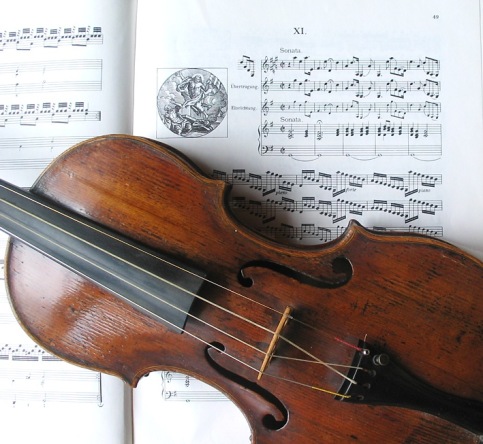Musicians from Apollo’s Fire:
Johanna Novom, violin
Adriane Post, violin
Karina Schmitz, violin
Carrie Krause, violin
William Simms, theorbo
Brian Kay, lute and guitar
René Schiffer, cello
Jeffrey Grossman, organ and harpsichord
St. Paul’s Episcopal Church
Cleveland Heights, OH
February 2, 2019
Biber: Selections from Sonatas on the Mysteries of the Rosary –
Sonata No. 1 in D minor, The Annunciation
Sonata No. 4 in D minor, The Presentation of Jesus
Bach: Prelude in C minor, BWV 999
Sonata No. 6 in C minor, The Agony in the Garden
Sonata No. 7 in F major, The Scourging at the Pillar
Sonata No. 10 in G minor, The Crucifixion
Bach: Cello Suite No. 5 in C minor, BWV 1011 – Sarabande
Johann Kerll: Toccata No. 8 in G major
Sonata No. 11 in G major, The Resurrection
Sonata No. 12 in C major, The Ascension
David Kellner: Campanella in D major
Sonata No. 14 in D major, The Assumption of Our Lady
Kaspar Förster: Motet in G minor, Dulcis amor Jesu
One of the most perplexing and endlessly fascinating instrumental works of the Baroque, Heinrich Biber’s Sonatas on the Mysteries of the Rosary (variously know as simply the Mystery Sonatas or Rosary Sonatas) served as the focus of this weekend’s Apollo’s Fire concerts. The complete cycle consists of fifteen sonatas for violin and continuo followed by a passacaglia for violin unaccompanied. Each of the fifteen sonatas evokes a scene from the Catholic Rosary, further divided into three sets of five, respectively, the Joyful, Sorrowful, and Glorious Mysteries. Despite the moniker of sonata, each embody a markedly unique structure from one another, and most remarkably, employ a different tuning through extensive use of scordatura. Only the opening sonata and closing passacaglia are scored for standard tuning, adding to the technical – and logistical – challenges of performing the work.

Eight of the fifteen sonatas were programmed, with four violinists each responsible for two. The instrumentation for the continuo is open to interpretation; the present performances opted for theorbo, lute, cello, keyboard, and various combinations thereof. Sonata No. 1 (“The Annunciation”) featured associate concertmaster Adriane Post. Beginning contemplative and rhapsodic, its centerpiece was a graceful aria which lent itself to elegant variations. Karina Schmitz offered sweeping power and a wide-ranging color palette to No. 4 (“The Presentation of Jesus”), a single-movement chaconne. At various intervals, solo works by other composers were offered as “meditations”, affording each of the continuo players a moment in the spotlight. The first such was lutenist Brian Kay in a prelude by Bach, a meditative work of understatement to which Kay offered deft control of the contrapuntal voices.
Co-concertmaster Johanna Novom was soloist in the dark No. 6 (“The Agony in the Garden”), digging into the depths of her instrument in this lament. No. 7, given by Carrie Krause, began with an unassuming allemande in congenial counterpoint with the organ, almost defiantly peaceful given its subject matter (“The Scourging at the Pillar”). A sarabande followed with dramatic flourishes – rather uncharacteristic of the form – and a striking central section wherein motion was all but suspended. Post offered a gripping reading of No. 10 (“The Crucifixion”), with the sharp snap of dotted rhythms eerily suggested the nails going in; a set of variations followed, impressive for the rapid passagework. Cellist René Schiffer closed the first half with a Bach sarabande, stately in its directness.
To open the final section – The Glorious Mysteries – was keyboardist Jeffrey Grossman (who was also on hand for an informative pre-concert lecture) in the Toccata No. 8 by Johann Kerll – a work of bright and brilliant virtuosity that presaged the light to come. Sonata No. 11 (“The Resurrection”) brought back Novom, and featured perhaps the most striking tuning of all – two Gs an octave apart, and two Ds also spaced by an octave, with the two middle strings forming a cross over the bridge for obvious symbolism (see picture above). The heart of the sonata was a chorale of resonant richness, at one point presented in octaves, readily achieved via the aforementioned tuning. Krause gave No. 12 (“The Ascension”) a commanding Intrada, contrasted by the joyful dance suite followed. William Simms presented David Kellner’s Campanella on the lute, a piece of perpetual arpeggiated figures. Schmitz concluded the Biber offerings with No. 14 (“The Assumption of Our Lady”), a rollicking final selection, especially in the concluding gigue. As a pendant to the Biber, the eight musicians at last joined forces simultaneously in an instrumental arrangement of a motet by Kaspar Förster – a moving blend of pathos and joy.
